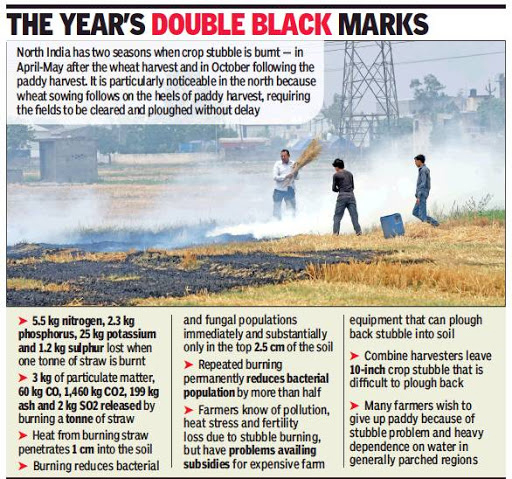Social Justice
Impact of Stubble Burning on Respiratory Health
- 08 Nov 2021
- 6 min read
Why in News
A study was conducted in Punjab that showed pollution from stubble burning significantly reduced lung function and was particularly harmful to women in rural Punjab.
- The study was conducted in two phases: The first was in October 2018 and again the following summer from March to April 2019.
Key Points
- High PM2.5 levels:
- The concentration of PM2.5 (Particulate Matter-2.5) was found to increase more than twice between the two phases, from 100 g/m3 to 250 g/m3.
- PM2.5 refers to particles that have a diameter less than 2.5 micrometres (more than 100 times thinner than a human hair) and remain suspended for longer.
- It causes respiratory problems and also reduces visibility. It is an endocrine disruptor that can affect insulin secretion and insulin sensitivity, thus contributing to diabetes.
- Incidentally these are around 10-15 times the WHO (World Health Organisation) prescribed air quality standards though the permissible standards by India’s Central Pollution Control Board (CPCB) are higher.
- WHO: The annual average concentrations of PM2.5 should not exceed 5 µg/m3, while 24-hour average exposures should not exceed 15 µg/m3 more than 3 - 4 days per year.
- CPCB: The annual average concentrations of PM2.5 should not exceed 40 µg/m3, while 24-hour average exposures should not exceed 60 µg/m3 more than 3 - 4 days per year.
- The concentration of PM2.5 (Particulate Matter-2.5) was found to increase more than twice between the two phases, from 100 g/m3 to 250 g/m3.
- Impact:
- A two to three-fold increase was noted in most of the respiratory symptoms including wheezing, breathlessness on exertion, skin rashes, itchiness of eyes etc. across all age groups (10-60 years).
- The highest number of respiratory complaints were reported by the elderly population (>40-60).
- There was decline in lung function with an increase in PM2.5 concentration.
- A 10-14% decline in lung function in men and nearly 15-18% decline in women across all age categories was noted.
- A two to three-fold increase was noted in most of the respiratory symptoms including wheezing, breathlessness on exertion, skin rashes, itchiness of eyes etc. across all age groups (10-60 years).
Stubble Burning
- About:
- Stubble (parali) burning is the act of setting fire to crop residue to remove them from the field to sow the next crop.
- In order to plant the next winter crop (Rabi crop), farmers in Haryana and Punjab have to move in a very short interval and if they are late, due to short winters these days, they might face considerable losses. Therefore, burning is the cheapest and fastest way to get rid of the stubble.
- It begins around October and peaks in November, coinciding with the withdrawal of southwest monsoon.
- Effects of Stubble Burning:
- Pollution:
- Emits large amounts of toxic pollutants in the atmosphere which contain harmful gases like methane (CH4), Carbon Monoxide (CO), Volatile Organic Compound (VOC) and carcinogenic polycyclic aromatic hydrocarbons.
- These pollutants disperse in the surroundings, may undergo a physical and chemical transformation and eventually adversely affect human health by causing a thick blanket of smog.
- Soil Fertility:
- Burning husk on the ground destroys the nutrients in the soil, making it less fertile.
- Heat Penetration:
- Heat generated by stubble burning penetrates into the soil, leading to the loss of moisture and useful microbes.
- Pollution:
- Alternatives to Stubble Burning:
- In-Situ Treatment of Stubble: For example crop residue management by zero-tiller machine and Use of bio-decomposers.
- Ex-Situ (off site) Treatment: For example use of rice straw as cattle fodder.
- Use of Technology- For example Turbo Happy Seeder (THS) machine, which can uproot the stubble and also sow seeds in the area cleared. The stubble can then be used as mulch for the field.
- Changing Cropping Pattern: It is the deeper and more fundamental solution.
- Bio Enzyme-PUSA: The Indian Agriculture Research Institute has devised a radical solution for stubble burning in the form of a bio-enzyme called PUSA.
- It leads to an increase in organic carbon and soil health while significantly reducing the fertiliser expense for the next cropping cycle.
- Other Action Plan:
- The State Governments of Punjab, National Capital Region (NCR) States and Government of National Capital Territory of Delhi (GNCTD) have developed detailed monitorable action plans based on the framework by the Commission for Air Quality Management (CAQM) to tackle the problem of air pollution.
Way Forward
- Imposing a fine is not going to work in our socio-economic conditions for curbing stubble burning. There is a need to focus on alternative solutions.
- Although the government is distributing but everyone is not getting the machines for in-situ management. The government should ensure their availability to everyone.
- Similarly, in ex-situ management, some companies have started collecting stubble for their use, but more effort on this front is needed.





